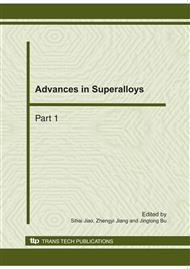p.26
p.34
p.38
p.42
p.63
p.70
p.75
p.79
p.89
New Method for Measuring the Viscosity of the Molten Amorphous Alloy
Abstract:
A new method, covering slag technology combining rotating cylinder method, has been proposed in this paper for measuring the viscosity of the molten amorphous alloy, and the viscosity of molten Zr50Cu50 alloy was measured. Furthermore, the changes of viscous activation energy Ev were analyzed. The measurement results showed: the viscosity of molten Zr50Cu50 alloy increases with decreasing temperature in the range of 1373 to 1208K and there is an overall exponential relationship. Two discontinuous points on the curve of lnη ~1/T have been found. After analyzing the changes of viscous activation energy Ev , the microstructure of molten alloy could be changed. The viscosity of molten Zr50Cu50 alloy is three orders of magnitude higher than that of some other alloys which is closely related with the excellent GFA of Zr50Cu50 alloy.
Info:
Periodical:
Pages:
63-69
Citation:
Online since:
October 2010
Authors:
Keywords:
Price:
Сopyright:
© 2011 Trans Tech Publications Ltd. All Rights Reserved
Share:
Citation:


